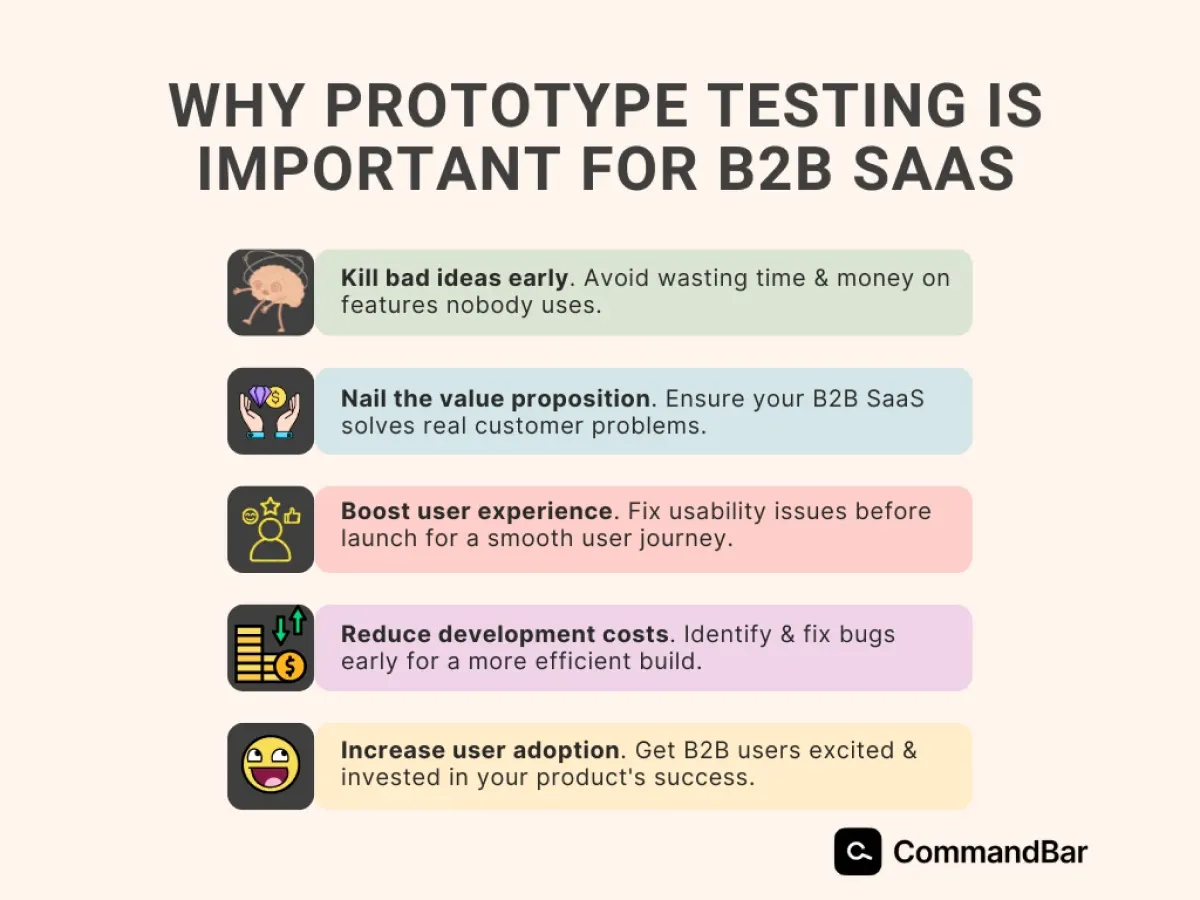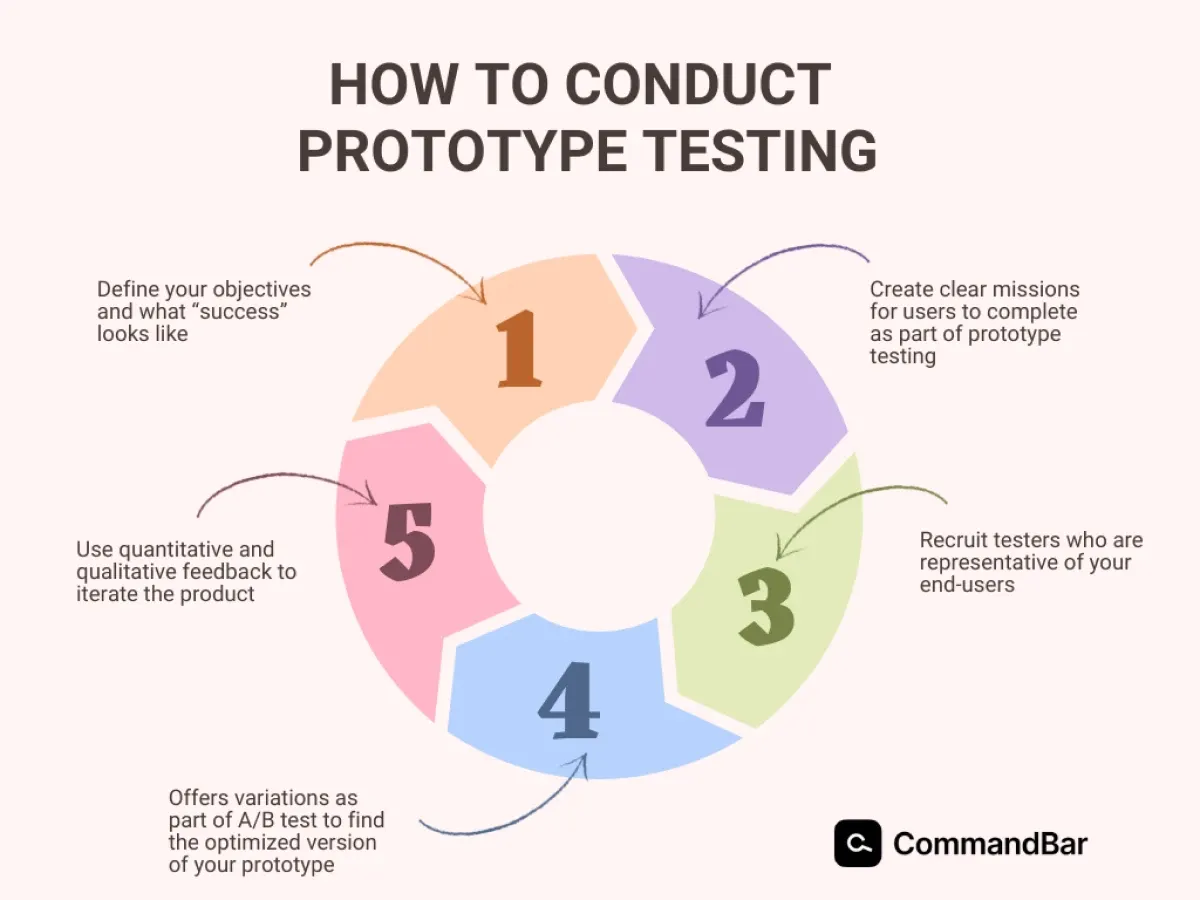Nothing is worse than spending weeks, perhaps even months, trying to develop a product, that ultimately does not meet the needs of the market or doesn’t quite deliver on the value proposition promised. B2B success depends on getting the product-market fit right, right from the start. Here’s where prototype testing comes in.
A prototype is a functional representation of your platform, essentially a test drive for your software before full development kicks in. By getting real-world users to interact with the prototype, you can see how users navigate your product, identify usability issues, and understand their initial impression of your product’s proposition.
Such user feedback allows you to iterate and improve on your prototype. Prototype testing isn't about avoiding wasted time (although it does help you do that too); it's about investing in building a product that resonates with your target market from the start.
De-risking your product with prototype testing
If you wanted to build a house, you wouldn’t kick off by putting together the building materials on day one, right? The first thing you’d do is build a blueprint and get the architects and designers to weigh in on the functionality, the economic feasibility, and the aesthetics of it. Prototype testing plays the same role for SaaS products.

Avoid costly mistakes early on
Prototype testing allows you to put a basic, functional product in front of your users. Users can help you figure out which features are unnecessary or don’t align with their workflows. Such knowledge can help you prioritize development resources on those features that truly add value.
The cost of fixing mistakes after launch can be substantial – after all you don’t want to take a product to market that has usability issues or poorly designed UI. By investing in prototype testing you can catch issues early on, reducing rework costs and minimizing wastage of resources.
Get the market fit right
The odds are stacked against new products. Only 40% of developed products ever reach the market, and even those that launch face an uphill battle, with only 60% generating revenue. Prototype testing can be your weapon against these odds.
By observing how users interact with your prototype, you can assess whether your solution truly addresses their needs and pain points and whether you deliver on the promised value proposition. It’s also possible that users may reveal needs you hadn't initially considered. Prototype testing will help you find such needs so you can refine your product offering.
Nail the user experience
A positive user experience is a non-negotiable for any B2B SaaS product. Get this wrong and product adoption will suffer.
Prototype testing makes it easy to test the usability of the product. Can users easily find the features they need? Is the navigation flow intuitive and efficient? You can observe user behavior to answer such questions and identify any roadblocks that hinder a user’s ability to complete tasks effectively.
What’s more, by involving users in early development, you generate excitement and build confidence in your product. That increases user buy-in, helping drive those user adoption numbers up!
How to use prototype testing for actionable insights

Getting prototype testing right means being one step closer to getting your product right for launch day. Here’s how you can incorporate it into the product development process at your organization.
Get real-world user feedback
Perhaps the best bit about prototype testing is that it goes beyond assumptions so you can gain true insights into how users interact with what you’re building. With prototype testing, you can observe user behavior, identify pain points, and understand how they navigate the functionalities you've designed. Such real-world feedback is crucial for refining your product and ensuring it addresses the specific needs of your B2B audience.
Make it a mission-driven test
Structure your prototype testing around specific objectives. Define clear "missions" for users to complete within the prototype. Such a focused approach allows you to assess user comprehension, identify any roadblocks in achieving their goals, and validate your product's overall usability.
A/B test to work your way towards an optimized product
Don't be afraid to experiment! Prototype testing allows you to conduct A/B tests, presenting users with variations for a particular feature or screen. You can conduct A/B testing on the design, messaging, or even the content used within the UI. By analyzing user behavior and engagement metrics, you can determine which variation performs better and iterate toward the optimal user experience.
Make use of quantitative data for better decisions
Move beyond subjective opinions and gain data-driven insights. Prototype testing solutions often provide a better insight into quantitative metrics such as:
- Success rates: Measure the percentage of users who successfully complete their assigned tasks within the prototype.
- Misclick rates: Identify areas where users are experiencing confusion or encountering unintended interactions.
- Time on task: Analyze how long it takes users to complete specific actions within the prototype. This data helps assess efficiency and identify potential bottlenecks.
Visualize user behavior with heatmaps
Heatmaps offer a visual representation of where users click, tap, or scroll within your prototype. This data helps identify areas of user focus and reveal any elements that might be getting overlooked. Leverage heatmaps to optimize information hierarchy and improve user engagement.
Elicit deeper feedback with surveys
Complement quantitative data with qualitative insights. Prototype testing solutions often allow you to embed surveys within the testing process so you use follow-up questions with scales or seek open-ended responses to gather deeper user feedback on their experience and suggestions for improvement.
Use prototype testing to perfect your product for launch day
It is one thing to start building a product knowing that there is a problem you want to address. It is quite another thing to actually be able to solve that problem in a way that appeals to the end-users.
Prototype testing offers a great opportunity to get in front of the actual users early in the development process. You can test the features you’re building, look at the user behavior as they interact with different design elements, and gauge how well they are responding to the value proposition and messaging your product marketing team has crafted.
The work doesn't stop after the testing phase. Once you've gathered feedback, it's time to analyze the data, iterate on your design, and refine your prototype based on user insights. This iterative process, fueled by valuable user feedback from prototype testing, is the key to launching a successful B2B SaaS product that meets the specific needs of your target market.
At the end of the day, it’s all about delivering a user-friendly experience that drives user acquisition and retention, and prototype testing helps you do just that.

















